Blowin’ In The Wind
update: 05-31-23 HEADLINE: U.S. battery storage capacity increased by 52% year over year, to 10.8 GW by the end of Q1 -- source; S&P Global
When it comes to Hawaii’s wind power potential, Bob Dylan got it right …“the answer my friend is blowin in the wind…”
background
It’s no secret that increases in demand for electricity is being accelerated by the growing demand from the electrification of ground transportation. The benefits of this transition is the reduction of Hawaii’s dependency on imported fossil fuels and less vehicle emissions (air pollution) within the state. Mitigating future climate impacts is also a benefit to the state’s residents and economy.
This change in electricity demand has also placed Hawaii in the crosshairs between grand policy expectations and a necessity for rapid clean energy transformation. In no island community is this more apparent than in the state’s most populated island, Oahu, where more than 56% of the state’s population lives and third in size, behind Maui and Hawaii Island.
In 2015 Hawaii set a target to achieve a 100% Renewable Portfolio Standard (RPS) by 2045. Sinc e that time the Hawai‘i Clean Energy Initiative (HCEI) was created as the framework for legislation that enables this transition to a clean energy economy. The HCEI has stated objectives of developing infrastructure, fostering innovation, creating economic opportunity, sharing their approach with other island communities, and building a workforce with new skills (Hawai‘i State Energy Office 2018)
Hawai‘i is also well suited to become the first state to achieve a 100% RPS. It has a relatively small load, high current electricity prices, heavy reliance on imported fossil fuels, and favorable conditions for wind and solar energy production (Energy Information Agency 2021).
Oahu’s Energy Dilemma
Oahu’s nearly one million residential population, further inflated by visitor traffic, has a tremendous hunger for energy. This same hunger previously justified the creation of the state’s only coal-fired power plant recently retired, and to this day, the state’s only active trash-burning power plant, in which toxic trash emissions and ash are traded for electricity, not the barter system the ancient Hawaiians had in mind for their resident homeland.
In this digital world of everything is on all the time, electricity is the currency that drives the economy and modern life. But tell that to Sunny Unga, a self-proclaimed community activist fighting the good fight, or so she believes. Previously reported in Civil Beat, Sunny represents some of the North Shore community and residents located near a wind farm who believe wind power and the turbines that delivery clean power electricity to her home and community are, well; …not in my backyard.
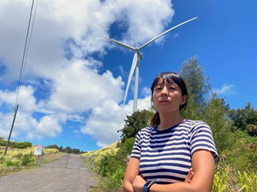 Hawaii’s activists pushing back against clean energy developments, in this case, have an audience that is listening, the Honolulu City Council. Presently the Council has three proposals being considered designed to protect communities from the placement of large wind energy projects too close to their backyards. The three bills range in project set back requirements from 2 to 5 miles from subdivisions, schools, and other populated developments. A reasonable solution, at least by some standards.
Hawaii’s activists pushing back against clean energy developments, in this case, have an audience that is listening, the Honolulu City Council. Presently the Council has three proposals being considered designed to protect communities from the placement of large wind energy projects too close to their backyards. The three bills range in project set back requirements from 2 to 5 miles from subdivisions, schools, and other populated developments. A reasonable solution, at least by some standards.
But for Oahu, any meaningful transition off its dirty energy addiction will take more than just project citing adjustments to advance its clean energy agenda, and wind power is a primary source solution for the state. While Maui and Hawaii Island have successfully adopted and welcomed wind power as part of the clean energy mix. limited land options coupled to population density and high energy demands, and limited clean power replacements translate into wind as one of two truly clean and zero polluting energy solutions for Oahu and the state of Hawaii which are blessed by being rich in clean, sustainable, and reliable natural energy options; wind and solar.
Hawaii’s Offshore Wind Resources Are Abundant
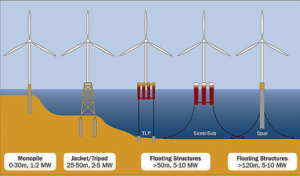 Offshore wind has the potential to deliver large amounts of clean, renewable energy to fulfill the electrical needs of cities along U.S. coastlines and Hawaii’s mid-Pacific location. Under conditions that foster offshore wind utilization, the National Renewable Energy Laboratory estimates that the technical resource potential for U.S. offshore wind is more than 4,200 gigawatts of capacity, or 13,500 terawatt-hours per year of generation.
Offshore wind has the potential to deliver large amounts of clean, renewable energy to fulfill the electrical needs of cities along U.S. coastlines and Hawaii’s mid-Pacific location. Under conditions that foster offshore wind utilization, the National Renewable Energy Laboratory estimates that the technical resource potential for U.S. offshore wind is more than 4,200 gigawatts of capacity, or 13,500 terawatt-hours per year of generation.
Wind turbines can be anchored to the sea floor in ocean depths exceeding 2,000 feet or as floating platforms. Decades of citing oil platforms in a variety near and far off-shore ocean conditions has created a wealth of knowledge and technology applications for citing wind turbines.
There are variety of Wind energy options, and in the case Oahu, sea-based off-shore wind turbine installations would prove to be not only cost effective to ratepayers, but a reliable clean energy source with minimum environmental and social side effects; a world class zero emissions energy source. Offshore wind also has the potential to contribute significantly to the state’s RPS. As series of island-based communities, Hawai‘i has a strong wind resource and a population (and corresponding electricity demand) concentrated along the coastline – a win-win energy opportunity for the state with off-shore wind.
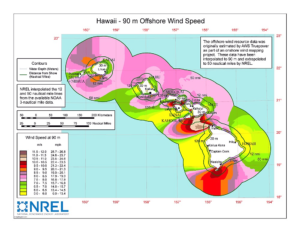
- Offshore wind turbines are also proving to be more efficient than land-based alternatives. Higher ocean wind speeds and consistency in direction means offshore installations require fewer turbines to produce the same amount of energy as onshore wind farms. The wind at sea is stronger, more consistent and less turbulent than on land. This means more power can be generated more reliably.
- Land-based battery storage will ensure these wind-powered energy sources are generating power for around the clock power grid and consumer demands.
The floating wind industry and its technology base continue to evolve rapidly. The progress in wind tech is driving greater costs reductions and operating efficiencies. Technology improvements continue to advance reductions in overall operating costs, already a cost effective alternative to fossil fueled power plants.
As stakeholders on Hawai‘i have strong cultural, social, and environmental ties to the land and surrounding ocean, collaborations between project developers and local community members will be required to identify the best technology choices for offshore wind. The results of these collabtive efforts could be regularly refined and updated to reflect the growth of the industry and ongoing collaborations with stakeholders on Hawai‘i.
Off-shore Wind Turbine installations – Cause and Effect
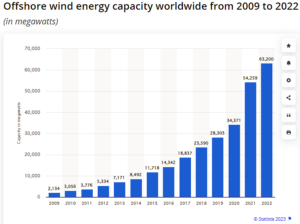 Deepwater wind turbine installations, more specifically, floating offshore wind energy facilities, also known as OWFs, and which are presently deployed are yielding more and more data that support previously assumptions of minimal effects on the marine environment from wind turbines. Off-shore wind turbine installations can also be installed beyond line-of-sight from the shoreline, aka over-the-Horizon installations which have no social impacts in terms of citing and view and minimal marine impact.
Deepwater wind turbine installations, more specifically, floating offshore wind energy facilities, also known as OWFs, and which are presently deployed are yielding more and more data that support previously assumptions of minimal effects on the marine environment from wind turbines. Off-shore wind turbine installations can also be installed beyond line-of-sight from the shoreline, aka over-the-Horizon installations which have no social impacts in terms of citing and view and minimal marine impact.
Using the available scientific literature from recent studies conducted, systematic reviews have estimated the potential environmental effects of deepwater, floating (wind platforms) OWFs during operation, as well as potential mitigation measures designed to mitigate operating effects on marine life with an emphasis on six areas of potential environmental effects from off-shore turbine operations. A recent synthesis of 89 articles selected for the review suggests that many projected environmental concerns did not exist or could be mitigated to pose a low risk to the marine environment if developers adopt appropriate mitigation strategies and best-practice protocols.
Conclusion
Hawaii’s energy stakeholders, which includes everyone in the state, should embrace the possibilities that Wind Energy offers. Not only as a replacement for much more harmful and expensive combustion energy sources which continue to represent the major of energy generation in the state today, but also as a companion to Solar Energy, which together in combination with today’s energy storage technology represent a truly clean energy economy that is a part of the environment, and not at war with it.
_____________________________________________________________
Article RESEARCH:
Related NEWS: 05.26.23:
Bottom-Dwelling Marine Animals Thriving on Offshore Wind Farm Foundations

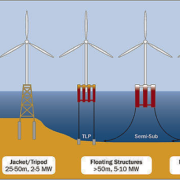


Land based wind generators produce most of their power during the day, as do solar panels. Do OWFs produce proportionally more power at night? If so, we would need less battery storage.
Plowing through piles of research referred to in this article, the following answer to your question is … “In many areas where offshore wind projects are planned, offshore wind speeds are highest during the afternoon and evening, when consumer demand is at its peak. Most land-based wind resources are stronger at night, when electricity demands are lower.”